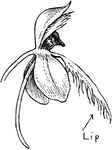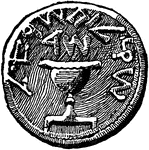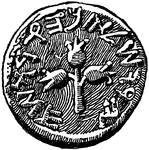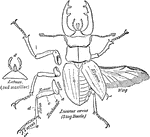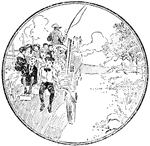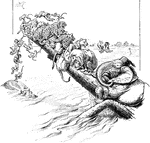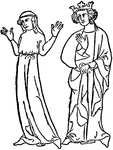
Horse Incisor Tooth
Incisor tooth of a horse-posterior view. Labels: a, outer layer of enamel; b, inner layer of enamel…
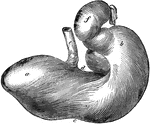
Horse Stomach
Posterior view of the stomach of a horse. Labels: a, left cul-de-sac; b, right cul-de-sac; c, greater…
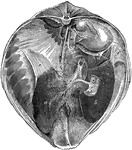
Liver and Diaphragm of a Horse
Posterior view of the liver and diaphragm in situ. Labels: a, left lobe; b, right lobe; c, quadrate…
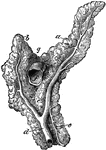
Pancreas of a Horse
Anterior view of the pancreas. Labels: a, left branch; b, right branch; c, inferior branch; d, duct…

Digestive Organs of a Horse
The relation of anterior abdominal digestive organs- left antero-lateral view. Labels: 1, liver; 2,…
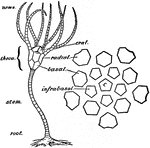
Simple Crinoid
An illustration of a simple five armed crinoid with a detailed view of the tegmen of five orals. Crinoids,…

Sea Urchin
An diagram of the anatomy of a sea urchin. Sea urchins are small, globular, spiny sea creatures, composing…

Chiton (Dorsal)
A dorsal view of a chiton, showing the eight shell plates. Chitons are small to large, primitive marine…

Chiton (Ventral)
A ventral view of a chiton, showing p, foot; o, mouth; kr, oval fringe; and br, the numerous ctenidia.…

Chiton with Shell Removed
An illustration of the dorsal view of a chiton with the shell removed. Showing b, buccal mass; ov, ovary;…
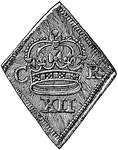
Newark Siege Piece - Obverse
"A coin, generally of unusual shape and rude workmanship, issued in a town or castle during a siege,…

Cranium of the Common Mudpuppy (Lateral View)
The Common Mudpuppy (Necturus maculosus) is a species of aquatic salamander found throughout the northeastern…
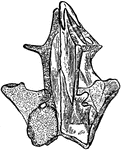
Cranium of the Common Mudpuppy (Dorsal View)
The Common Mudpuppy (Necturus maculosus) is a species of aquatic salamander found throughout the northeastern…
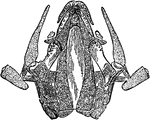
Cranium of the Common Mudpuppy (Ventral View)
The Common Mudpuppy (Necturus maculosus) is a species of aquatic salamander found throughout the northeastern…
Head of Ichthyophis Glutinosus
Ichthyophis glutinosus or Ceylon Caecilian is a species of amphibian in the Ichthyophiidae family. Pictured…

Dial Driving Device
An illustration of Hope Jone's dial-driving device. "Each time that a current is sent by the master…

Hispid Cotton Rat
The Hispid Cotton Rat (Sigmodon hispidus) is a small rodent in the Cricetidae family of New World rats…
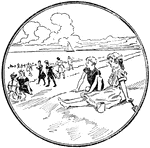
Relaxing on the Beach
Two young people sitting on the beach. Others are walking along the shore. There is a sailboat in the…

Dissection of the Renal Organs of a Chiton
An illustrative view of the dissection of he renal organs of a chiton. "F, foot; L, Edge of the mantle…
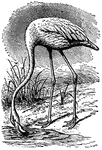
Flamingo
Flamingos are gregarious wading birds in the genus Phoenicopterus and family Phoenicopteridae. They…
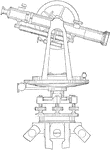
Transit Telescope
A transit telescope is a special purpose telescope mounted so as to allow it to be pointed only at objects…

Indian Pillar from the Rock Temple of Parasona Rama at Ellora
Jain caves reveal specific dimensions of Jain philosophy and tradition. They reflect a strict sense…

Interior of Indra Sabha at Ellora
Jain caves reveal specific dimensions of Jain philosophy and tradition. They reflect a strict sense…

Indian Pillar at Ellora
Jain caves reveal specific dimensions of Jain philosophy and tradition. They reflect a strict sense…

Repair Link of Chain
"Repair-link for round-link chain. A, section by a meridian plane; B, perspective elevation showing…

Larynx Muscles of a Horse
Muscles of the larynx-left lateral view. Labels: a, hyoepiglottideus; b, hyothyroideus; c, cricothyroideus.
Larynx Muscles of a Horse
Muscles of the larynx-left lateral view-the thyroid wing being removed. Labels: a, arytenoideus; b,…

Respiratory Organs of a Horse
General view of the respiratory organs. Labels: a, septum nasi; b, posterior naris; c, larynx; d, trachea;…

Liver of an Ox
Posterior view of the liver of an ox. Labels: a, left lobe; b, right lobe; c, spigelian lobe; d, quadrate…
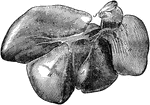
Liver of a Hog
Liver of a hog-posterior view. Labels: a, right external lobe; c, left external lobe; d, left internal…
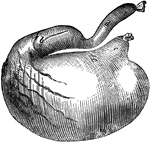
Stomach of a Dog
Stomach of a dog-inflated. Labels: a, cardiac portion; b, pyloric portion; c, esophageal orifice; d,…

Thigh of a Horse Showing Arteries
Internal view of left thigh-showing the arteries. Labels: 1, femoral; a, profunda femoris; b, superficialis…

Leg of a Horse Showing Arteries
Arteries of the right posterior limb- external view. Labels: 1, popiteal; 2, posterior tibial; 3, anterior…

Pillar in Trimal Naik's Tschultri
A pillar is similar to a column which is a vertical support structure in architecture, but the base…
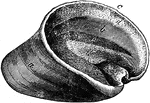
Hoof of a Horse
Detached hoof- supero-lateral view. Labels: a, crust or outer layer of the wall; b, horny laminae; c,…

Great Pyramid of Giza
The Great Pyramid of Giza, also called Khufu's Pyramid or the Pyramid of Khufu, and Pyramid of Cheops,…
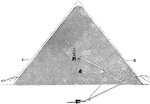
Great Pyramid of Giza, Cross Section
The Great Pyramid of Giza, also called Khufu's Pyramid or the Pyramid of Khufu, and Pyramid of Cheops,…

Great Pyramid of Giza, Section of the Grand Gallery
The Grand Gallery features a corbel haloed design and several cut "sockets" spaced at regular…
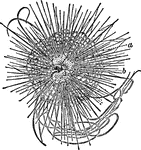
Sea Urchin
Sea urchins are small, globular, spiny sea creatures, composing most of class Echinoidea. They are found…
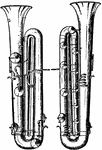
French Contrabassoon
An illustration of the front (right) and back (left) of the French contrabassoon.
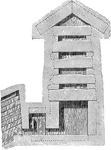
Great Pyramid of Giza, King's Chamber
The King's Chamber is lined with red granite brought from Aswan 935 km (580 miles) to the south, of…
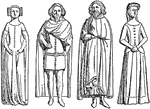
Children of Edward II
An illustration of King Edward II's children: Eleanor, Edward, John, and Joanna.
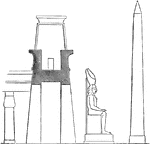
Pylon at the Palace at Luxor, Profile with Colossal Statue and Obelisk
Luxor Temple is a large Ancient Egyptian temple complex located on the east bank of the River Nile in…

Annual Honesty
Annual Honesty (Lunaria annua) is a tall (height about 1 m), hairy-stemmed biennial plant found throughout…
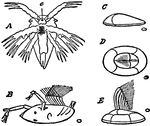
Early Stages of Balanus
An illustration showing the early stages of balanus: A, nauplis (larva); e, Eye; B, Cypris-larva with…

Back View of the Temple of Philæ
The serious, solemn, and awe-inspiring efect which the general arrangement of the temple produces is…

Sansa
"Sansa. An African musical instrument which consists of a sounding-board of some hard wood with strips…

Sarinda
"Sarinda. A Hindu viol, which has a body made of a single wooden block, elliptical in general contour,…

Interior of the Temple of Philæ
The interior has a richer appearance, chiefly owing to the use of columns of a round cylindrical shape.…
Profile of the Colossal Statue on a Pier at the Luxor Temple
Instead of columns, square piers are not infrequently introduced in the tombs. In structural buildings…

